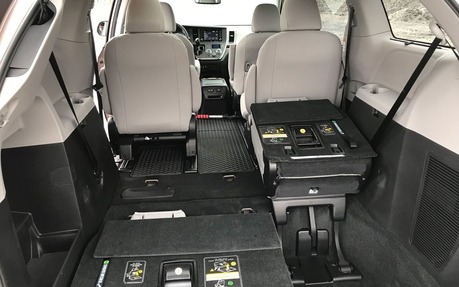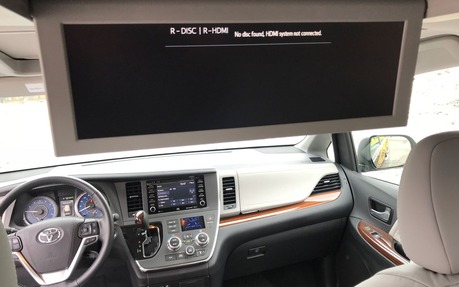2018 Toyota Sienna: an Older Product, but Still Palatable
The current, third-generation Toyota Sienna was released way back in 2011, which means this vehicle is in its eighth production year—a bit of an elder in the automotive industry. A manufacturer can get away with this if the product is good, so this is an early indication of what to expect from the Sienna.
I find it a little ironic considering bold designs tend not to age well, but the Sienna bucks this trend. Toyota has tweaked the look for 2018 including a larger lower grille, larger fog light compartments, plus sculpted lower rocker panels from the SE, giving the Sienna an aggressive look across all grades.
- Also: 2017 Toyota Sienna: Family First
- Also: A recall for the Toyota Sienna and its power-sliding doors
A new powertrain was incorporated into the Sienna last year—the D-4S direct-injection V6 and Direct Shift eight-speed automatic transmission. The engine produces 296 horsepower and 263 lb.-ft. of torque and, in partnership with the transmission’s eight ratios, makes the Sienna a rapid hauler. All-wheel drive with active torque control is available for the LE, XLE, and Limited, providing an important all-weather traction advantage that is not found in any other family van. The standard Tow Prep Package allows the Sienna to pull a 3500-pound-max load.
The test vehicle was the top-of-the-line Limited trim which includes a ten-speaker Entune Audio 3.0 sound system, eight-inch touchscreen infotainment system, navigation, a 16.4-inch widescreen rear entertainment system including two sets of wireless earphones, a panorama sunroof, leather seats and Toyota Safety Sense.

It’s easy to get in and out of the Sienna’s third row, thanks to the sliding captain’s chairs in the second row. They are also handy if you want to move your children closer for easier access. An eight-seater configuration is possible with a removable middle seat in the second row. The Chrysler Pacifica has a serious edge with Stow ‘n Go seating in the second row which allows the chairs to simply fold into the floor. It’s a lot more convenient than having to remove and store the seats should you not need them. Another nifty feature not found in the Sienna is a vacuum, like in the Pacifica and the Honda Odyssey. Kids make a heck of a mess and a built-in vacuum just makes so much sense to have. The Sienna also doesn’t have as much second- and third-row legroom as some competitors, but is still plenty comfortable for adults to sit in.
The third-row stow operation was very easy to execute, and anyone would be able to carry out the three-step process with ease. The 2011 Caravan I owned had a four-step process that was clearly inferior to the Sienna’s.
The Sienna’s cockpit is spacious, if a little outdated. The overbearing flat panel control surface with massive buttons is aesthetically a bit odd, but certainly functional. Unfortunately, it’s the other way around with the infotainment’s touchscreen interface. Toyota’s system has small buttons and a layout that isn’t the most intuitive. It’s also a bit far away from the driver, which makes operating it a little difficult.
I was especially anxious to try out the rear-seat entertainment system. The screen is massive and the display can be used to display one or two different inputs. Wireless headphones and handy in case parents would like some peace and quiet and the interface was adequate. There was a major issue that needs to be mentioned because it interfered with the overall user experience—the difficulty level in operating a DVD.

You can put the disc in, but all further control (except for play/pause) must be done via remote from the rear two rows. If you want to skip the previews on your movie, you must climb in the back to do it. Want to skip a track during a movie? You’d have to pull over and get in the back to do it. If all of your kids are over six years old, then it’s not a big deal, but there is no reason to omit basic disc control from the front. I’m not asking to be able to watch the movie (though that would be nice while parked) but skipping a movie track or having access to the disc menu is no different than a music menu and should be available to the driver.
The Toyota Sienna remains a viable contender in the minivan segment despite its age. Toyota’s reputation for build quality and reliability together with the vehicle’s seemingly ageless looks are still a winning combination. The base seven-passenger Sienna starts at $34,690 before freight and delivery charges, and the loaded Limited trim rings in at $50,690.
| Test drive report | |
| Test model | 2018 Toyota Sienna |
|---|---|
| Trim level | Limited |
| Price range | $34,690 – $53,290 |
| Price as tested | 53 290 $ |
| Warranty (basic) | N/A |
| Warranty (powertrain) | N/A |
| Fuel economy (city/highway/observed) | 13,4 / 9,6 / 15,0 L/100km |
| Options | N/A |
| Competitive models | Chrysler Pacifica, Dodge Grand Caravan, Honda Odyssey, Kia Sedona |
| Strong points |
|
| Weak points |
|
| Editor's rating | |
| Fuel economy | Only city driving, but I had hoped for a little better. |
| Comfort | Very comfortable all around. |
| Performance | Quite peppy. Very quiet on the highway. |
| Infotainment | The complicated menus and difficulty with the DVD system make it difficult to give a passing grade. |
| Driving | A smooth and quiet experience. |
| Overall | Still a reasonable option to consider in the minivan segment. |
